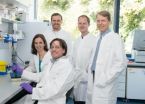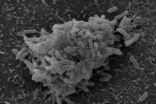(Press-News.org) >
Our immunosensory system detects virus such as influenza via specific characteristics of viral ribonucleic acid. Previously, it was unclear how the immune system prevents viruses from simply donning molecular camouflage in order to escape detection. An international team of researchers from the University of Bonn Hospital and the London Research Institute have now discovered that our immunosensory system attacks viruses on a molecular level. In this way, a healthy organism can keep rotaviruses, a common cause of diarrheal epidemics, at bay. The results have been published in the renowned journal Nature.
Every day our bodies are confronted with a variety of viruses and other pathogens. Our immune systems must constantly decide what is "foreign" and what is part of the body itself so that the body's own cells are not inadvertently attacked by its own defense troops. Viruses imitate the body's own structures and thus represent a special challenge for the immune system. In this way, the immune system works like a sensory organ which continuously detects dangers and initiates the appropriate defense mechanisms. This immunosensory system searches for viruses by surveilling the body's own ribonucleic acid (RNA) for RNA with characteristics typical of viruses. In RNA viruses, RNA is the carrier of the virus's genetic information. To reproduce, viruses must multiply their RNA, and this multiplication leads to the development of molecular patterns which are in turn used to detect the viruses themselves.
It has been known for some time that RIG-I-like receptors (RLRs) play a crucial role in the detection of RNA viruses. These receptors act as "fire alarms" within the immune system: When RNA molecules from viruses bind to these receptors, a signal chain is initiated that leads to the production of substances that can ultimately combat the viruses. "During amplification of viral RNA, a so-called triphosphate group, consisting of three phosphates, inevitably develops at one end of the newly formed RNA. A few years ago, we were the first to show that it is this triphosphate group which allows RIG-I to detect newly formed viral RNA. Previously, it was believed that viruses can elude this detection via simple deceptive molecular maneuvers," said Prof. Gunther Hartmann, Director of the Institute of Clinical Chemistry and Clinical Pharmacology of the University of Bonn Hospital.
RIG-I: A Molecular Attack Against Viruses
Together with scientists from the Immunobiology Laboratory of the London Research Institute in England, the scientists working with Dr. Martin Schlee and Prof. Dr. Gunther Hartmann at the University of Bonn Hospital investigated the immunorecognition of reoviruses. This family includes rotaviruses, which cause serious diarrheal illness and are responsible for the deaths of more than a million children worldwide every year. The immunorecognition of reoviruses was previously unclear since their RNA does not contain a triphosphate group. Now the researchers discovered that, surprisingly, an RNA structure with two phosphates at the end of the RNA double-strand in reoviruses can likewise trigger RIG-I and alarm the immune system.
"This finding has significance for the detection of RNA viruses that extends far beyond reoviruses: It is comparatively simple for a virus to molecularly change the triphosphate in the course of its development," said Dr. Schlee. The first step in this process is generally to split off the outermost phosphate of the triphosphate group, which leads to a diphosphate. This step is necessary for the virus to perform further modifications to its RNA and thus don a molecular cloak of invisibility. However, any form of further molecular camouflage is made extremely difficult for the virus due to the additional highly specialized RIG-I-mediated immunorecognition of the diphosphate. Thus, RIG-I attacks the virus on both fronts, significantly restricting its further development. "Without the investigation into reoviruses, we would not have discovered this universal mechanism of virus detection," said Prof. Hartmann. Since members of the reovirus family also contain a diphosphate group in their viral RNA, a healthy organism can also detect these viruses and curb these illnesses within a few days. However, malnourished children cannot summon these reserves, and the illness can become life-threatening.
The Immune System: A Sensory System for Health
The researchers see a major application potential in the decoding of virus detection: "We are already currently developing artificially produced copies of viral RNA in order to alert our immune system to viruses in a targeted fashion," said Prof. Hartmann who is also director of the project "Novel Anti-infective Agents" at the German Centre for Infection Research (DZIF). Prof Hartmann is also currently speaker of the Cluster of Excellence ImmunoSensation, which is supported by a 28-million Euro grant from the German Research Foundation (DFG). The Cluster brings together experts from a variety of disciplines at the site and connects them to international research structures.
INFORMATION:
Publication: Antiviral immunity via RIG-I-mediated recognition of RNA bearing 5'diphosphates, Nature, DOI: 10.1038/nature13590
Keeping viruses at bay
Researchers at the University of Bonn Hospital discover how our organism definitively detects RNA viruses
2014-08-11
ELSE PRESS RELEASES FROM THIS DATE:
Fertile discovery
2014-08-11
Queen's University researcher Richard Oko and his co-investigators have come up with a promising method of treating male infertility using a synthetic version of the sperm-originated protein known as PAWP.
They found this protein is sufficient and required to initiate the fertilization process.
Dr. Oko's research promises to diagnose and treat cases of male factor infertility where a patient's sperm is unable to initiate or induce activation of the egg to form an early embryo.
"PAWP is able to induce embryo development in human eggs in a fashion similar to the natural ...
Penn-led expert panel calls for public health research on natural gas drilling
2014-08-11
PHILADELPHIA – Groundwater and air quality testing before, during, and after natural gas drilling – which includes hydraulic fracturing -- should be key components of efforts to ensure the safety of communities near these sites, according to an expert panel convened to weigh in on public health research needs associated with unconventional natural gas drilling operations (UNGDO). The panel also urges that any research conducted should use "community-based participatory research principles" so that the concerns of the many stakeholders involved in these activities can be ...
Rutgers researchers show that how fast you drive might reveal exactly where you are going
2014-08-11
In our constantly connected, information-rich society, some drivers are jumping at the chance to let auto insurance companies monitor their driving habits in return for a handsome discount on their premiums.
What these drivers may not know is that they could be revealing where they are driving, a privacy boundary that many would not consent to cross.
A team of Rutgers University computer engineers has shown that even without a GPS device or other location-sensing technology, a driver could reveal where he or she traveled with no more information than a starting location ...
School violence, gun-related injury among top 10 child health concerns nationally
2014-08-11
ANN ARBOR, Mich. – Childhood obesity remains the top health concern for children in 2014, but when asked about national concerns, adults put school violence and gun-related injuries in the top 10, according to a new University of Michigan C.S. Mott Children's Hospital National Poll on Children's Health.
In the poll's annual top 10 list, a nationwide sample of adults were asked to identify the biggest health concerns for kids in their communities, as well as kids nationwide. Overall, childhood obesity is rated at the top of both lists: 29 percent of adults said obesity ...
Inequality -- a key issue of economic research
2014-08-11
In the aftermath of the global financial crisis and the ensuing economic and political disruptions, inequality has re-emerged as a central focus of public debate. The drivers of rising inequality of income and wealth and the various scientific models for counteractive measures will be among the central topics debated among 17 Nobel Laureates in Economic Sciences and approximately 450 aspiring young economists from more than 80 countries in Lindau, Germany, next week. The 5th Lindau Meeting on Economic Sciences will bring them together for a unique dialogue across generations, ...
Clues emerge to genetic architecture of cognitive abilities in children
2014-08-11
How genes affect intelligence is complicated. Multiple genes, many yet unknown, are thought to interact among themselves and with environmental factors to influence the diverse abilities involved in intelligence.
A large new genetic study in thousands of children and adolescents offers early glimpses of the overall patterns and connections among cognitive abilities such as language reasoning, reading skill and types of memory. The findings may lead to new tools in understanding human cognitive development and neuropsychiatric disorders.
"This research is one of the ...
More intensive interventions needed to combat severe obesity in teens
2014-08-11
New Rochelle, NY, August 11, 2014 -- Nearly 6% of all children and teens in the U.S. are severely obese, and the prevalence of severe obesity is increasing faster than that of moderate obesity or overweight. This is an alarming trend as about 90% of these youths will grow up to be obese adults. The serious health problems associated with severe obesity and the poor long-term prognosis and quality of life projected for these children and teens demand more serious consideration of safe and effective treatment options that go beyond diet and lifestyle modifications, as proposed ...
Pairing old technologies with new for next-generation electronic devices
2014-08-11
UCL scientists have discovered a new method to efficiently generate and control currents based on the magnetic nature of electrons in semi-conducting materials, offering a radical way to develop a new generation of electronic devices.
One promising approach to developing new technologies is to exploit the electron's tiny magnetic moment, or 'spin'. Electrons have two properties – charge and spin – and although current technologies use charge, it is thought that spin-based technologies have the potential to outperform the 'charge'-based technology of semiconductors for ...
Sugary bugs subvert antibodies
2014-08-11
A lung-damaging bacterium turns the body's antibody response in its favor, according to a study published in The Journal of Experimental Medicine.
Pathogenic bacteria are normally destroyed by antibodies, immune proteins that coat the outer surface of the bug, laying a foundation for the deposition of pore-forming "complement" proteins that poke lethal holes in the bacterial membrane. But despite having plenty of antibodies and complement proteins in their bloodstream, some people can't fight off infections with the respiratory bacterium Pseudomonas aeruginosa. And chronic ...
Tackling liver injury
2014-08-11
A new drug spurs liver regeneration after surgery, according to a paper published in The Journal of Experimental Medicine.
Liver cancer often results in a loss of blood flow and thus oxygen and nutrients to the liver tissue, resulting in deteriorating liver function. Although the diseased part of the liver can often be surgically removed, the sudden restoration of blood flow to the remaining liver tissue can trigger inflammation—a process known as ischemia reperfusion injury (IRI). IRI results in part from the deposition of immune proteins called complement on the surface ...
LAST 30 PRESS RELEASES:
How does age affect recovery from spinal cord injury?
Novel AI tool offers prognosis for patients with head and neck cancer
Fathers’ microplastic exposure tied to their children’s metabolic problems
Research validates laboratory model for studying high-grade serous ovarian cancer
SIR 2026 delivers transformative breakthroughs in minimally invasive medicine to improve patient care
Stem Cell Reports most downloaded papers of 2025 highlight the breadth and impact of stem cell research
Oxford-led study estimates NHS spends around 3% of its primary and secondary care budget on the health impacts of heat and cold in England
A researcher’s long quest leads to a smart composite breakthrough
Urban wild bees act as “microbial sensors” of city health.
New study finds where you live affects recovery after a hip fracture
Forecasting the impact of fully automated vehicle adoption on US road traffic injuries
Alcohol-related hospitalizations from 2016 to 2022
Semaglutide and hospitalizations in patients with obesity and established cardiovascular disease
Researchers ‘listen in’ to embryo-mother interactions during implantation using a culture system replicating the womb lining
How changing your diet could help save the world
How to make AI truly scalable and reliable for real-time traffic assignment?
Beyond fragmented markets: A new framework for efficient and stable ride-pooling
Can shape priors make road perception more reliable for autonomous driving?
AI tracks nearly 100 years of aging research, revealing key trends and gaps
Innovative techniques enable Italy’s first imaging of individual trapped atoms
KIER successfully develops Korea-made “calibration thermoelectric module” for measuring thermoelectric device performance
Diversifying US Midwest farming for stability and resilience
Emphasizing immigrants’ deservingness shifts attitudes
Japanese eels, climate change, and river temperature
Pusan National University researchers discover faster, smarter heat treatment for lightweight magnesium metals
China’s 2024 Gastroenterology Report: marked progress in endoscopy quality and disease management
Pusan National University researchers uncover scalable method for ultrahigh-resolution quantum dot displays
Researchers use robotics to find potential new antibiotic among hundreds of metal complexes
Gut bacteria changes at the earliest stages of inflammatory bowel disease
Scientists develop new way to “listen in” on the brain’s hidden language
[Press-News.org] Keeping viruses at bayResearchers at the University of Bonn Hospital discover how our organism definitively detects RNA viruses




